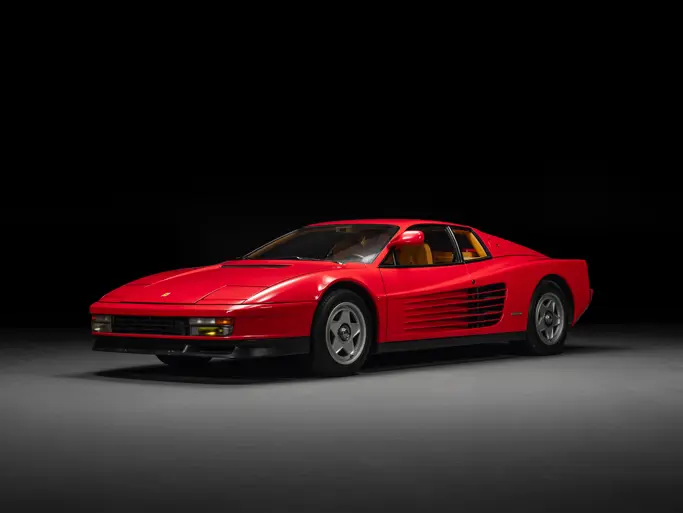
1978 Ferrari 512 BB
{{lr.item.text}}
$320,000 - $350,000 USD | Not Sold
{{bidding.lot.reserveStatusFormatted}}
- Mid-mounted 4,942-cc, 360-hp flat 12-cylinder engine
- Five-speed manual transmission
- Reported in original condition
- Two owner car
- 2015 engine-out belt service
- Original books and toolkit
- Factory knock-off & Michelin XWX tires
- Air conditioning
- Service-related paperwork
- Fewer than 1,000 built over five years
If you saw the Ferrari 512 BB upon introduction, it is easily burned into your memory. The greatly observed Ferrari Formula 1 team was running their famous flat 12-cylinder engines; winning races and championships with drivers of the era now viewed as some of the most revered in the sports history: Lauda, Regazzoni, Villeneuve, Scheckter and Reutemann. To see this type of power on display in a Ferrari road car was absolutely unforgettable; conceivably there was a chance to emulate your racing heroes.
Perhaps the Pininfarina-designed 512 BB was not regarded as the most beautiful of its type amongst peers, but it certainly made a statement that wasn’t subtle. Powerful and aggressive more fit the bill with smooth Italian lines and fat Michelin tires. The first thought upon seeing such a car is often, “just how fast?” The point is, few have the abilities to thoroughly push such a car to the limits, but you can take this car far within your comfort threshold. Respected Road & Track test drivers and writers shared that they thought the Boxer Berlinetta “has it all, the speed, the handling, the lovely shape, the well done cockpit and, most of all, a reputation for reliability.”
Ferrari built its first horizontally-opposed (flat) engine in 1964 – a 12-cylinder, 1.5-liter Formula One unit with 210-hp. Called “boxers,” the term originated in reference to early Volkswagen and Porsche engines. It was coined to refer to the pistons which moved both toward and away from each other, much like sparring fighters.
Ferrari introduced the 365 GT/4 BB in 1974. The name translated to 365-cc per cylinder, grand touring, four-cam, Berlinetta Boxer. The 4.4-liter flat-twelve was mid-mounted and would become the first Ferrari to use a toothed belt to drive the overhead camshafts. Ferrari built upon the success of the 365 GT/4 BB beginning in late-1976 with the introduction of the 512 BB. The name reflected Ferrari’s typical liters/cylinders numbering as seen on the factory racecars of the period. Interestingly, it was being built two months before it was introduced at the Paris show in October; another first for Ferrari.
The new 512 featured a small chin spoiler in front, NACA ducts on the lower body sides ahead of the rear wheels, four taillights (in lieu of six), pop-up headlights, cockpit-level spoiler located mid-ship, five-speed gearbox, power-assisted four-wheel disc brakes, Weber carburetors, rack-and-pinion steering, clamshell-type front and rear deck hinging, plus a tail 1.5 inches longer. The flat-twelve was upsized to 4,942-cc and horsepower increased to 360. In 1978, Road & Track reported a 0- to 60-mph sprint in 5.5 seconds, a 1/4-mile run of 14.2 seconds at 103.5-mph, and an estimated top speed of 188-mph – staggering performance at the time. Summing it up, R&T said, “The Boxer wins a more important award as the best all-around sports and GT car we’ve tested.”
Reported in original condition, this 1978 Ferrari 512 BB looks fantastic in its red finish with black leather seats and red carpet. This two-owner car displays less than 16,000 miles on the odometer; the owner believes these to be actual as reflected by the car’s condition, but the title is exempt. It has recently benefitted from an engine-out belt service that was executed in 2015. The original books accompany this exceptional machine, as does the valued toolkit with case and leather roll for the jack. Wearing factory spec Michelin XWX tires with knock-off factory issue Cromodora wheels; this BB is also equipped with Veglia analog gauges with day-glow markings, air conditioning, Kenwood AM/FM/CD, along with assorted service-related paperwork.
Fewer than 1,000 512 BBs were assembled, none of which were destined for Ferrari’s growing American market. The reasoning behind this was that Enzo Ferrari himself did not believe that the vehicle should be detuned to comply with increasingly stringent federal emissions standards. However; numerous 512 BBs were certified by independent importers for the American market.


 | Santa Monica, California
| Santa Monica, California


